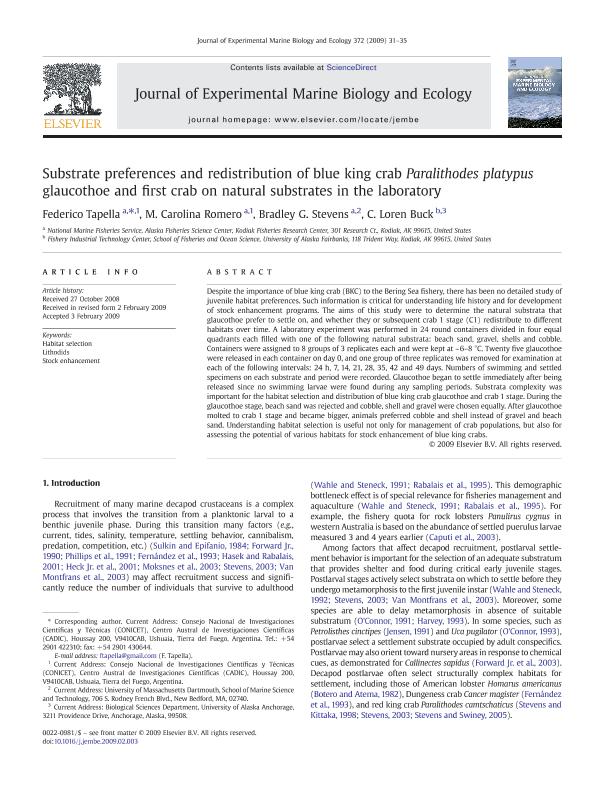Mostrar el registro sencillo del ítem
dc.contributor.author
Tapella, Federico

dc.contributor.author
Romero, Maria Carolina

dc.contributor.author
Stevens, Bradley G.
dc.contributor.author
Buck, Charles Loren

dc.date.available
2021-02-18T13:23:36Z
dc.date.issued
2009-04
dc.identifier.citation
Tapella, Federico; Romero, Maria Carolina; Stevens, Bradley G.; Buck, Charles Loren; Substrate preferences and redistribution of blue king crab Paralithodes platypus glaucothoe and first crab on natural substrates in the laboratory; Elsevier Science; Journal of Experimental Marine Biology and Ecology; 372; 1-2; 4-2009; 31-35
dc.identifier.issn
0022-0981
dc.identifier.uri
http://hdl.handle.net/11336/125919
dc.description.abstract
Despite the importance of blue king crab (BKC) to the Bering Sea fishery, there has been no detailed study of juvenile habitat preferences. Such information is critical for understanding life history and for development of stock enhancement programs. The aims of this study were to determine the natural substrata that glaucothoe prefer to settle on, and whether they or subsequent crab 1 stage (C1) redistribute to different habitats over time. A laboratory experiment was performed in 24 round containers divided in four equal quadrants each filled with one of the following natural substrata: beach sand, gravel, shells and cobble. Containers were assigned to 8 groups of 3 replicates each and were kept at ~ 6-8 °C. Twenty five glaucothoe were released in each container on day 0, and one group of three replicates was removed for examination at each of the following intervals: 24 h, 7, 14, 21, 28, 35, 42 and 49 days. Numbers of swimming and settled specimens on each substrate and period were recorded. Glaucothoe began to settle immediately after being released since no swimming larvae were found during any sampling periods. Substrata complexity was important for the habitat selection and distribution of blue king crab glaucothoe and crab 1 stage. During the glaucothoe stage, beach sand was rejected and cobble, shell and gravel were chosen equally. After glaucothoe molted to crab 1 stage and became bigger, animals preferred cobble and shell instead of gravel and beach sand. Understanding habitat selection is useful not only for management of crab populations, but also for assessing the potential of various habitats for stock enhancement of blue king crabs.
dc.format
application/pdf
dc.language.iso
eng
dc.publisher
Elsevier Science

dc.rights
info:eu-repo/semantics/openAccess
dc.rights.uri
https://creativecommons.org/licenses/by-nc-sa/2.5/ar/
dc.subject
HABITAT SELECTION
dc.subject
LITHODIDS
dc.subject
STOCK ENHANCEMENT
dc.subject.classification
Ecología

dc.subject.classification
Ciencias Biológicas

dc.subject.classification
CIENCIAS NATURALES Y EXACTAS

dc.title
Substrate preferences and redistribution of blue king crab Paralithodes platypus glaucothoe and first crab on natural substrates in the laboratory
dc.type
info:eu-repo/semantics/article
dc.type
info:ar-repo/semantics/artículo
dc.type
info:eu-repo/semantics/publishedVersion
dc.date.updated
2021-01-18T14:17:45Z
dc.journal.volume
372
dc.journal.number
1-2
dc.journal.pagination
31-35
dc.journal.pais
Países Bajos

dc.description.fil
Fil: Tapella, Federico. Consejo Nacional de Investigaciones Científicas y Técnicas. Centro Austral de Investigaciones Científicas; Argentina
dc.description.fil
Fil: Romero, Maria Carolina. Consejo Nacional de Investigaciones Científicas y Técnicas. Centro Austral de Investigaciones Científicas; Argentina
dc.description.fil
Fil: Stevens, Bradley G.. Kodiak Fisheries Research Center; Estados Unidos
dc.description.fil
Fil: Buck, Charles Loren. University of Alaska Fairbanks; Estados Unidos
dc.journal.title
Journal of Experimental Marine Biology and Ecology

dc.relation.alternativeid
info:eu-repo/semantics/altIdentifier/url/https://www.sciencedirect.com/science/article/abs/pii/S0022098109000719
dc.relation.alternativeid
info:eu-repo/semantics/altIdentifier/doi/https://doi.org/10.1016/j.jembe.2009.02.003
Archivos asociados
